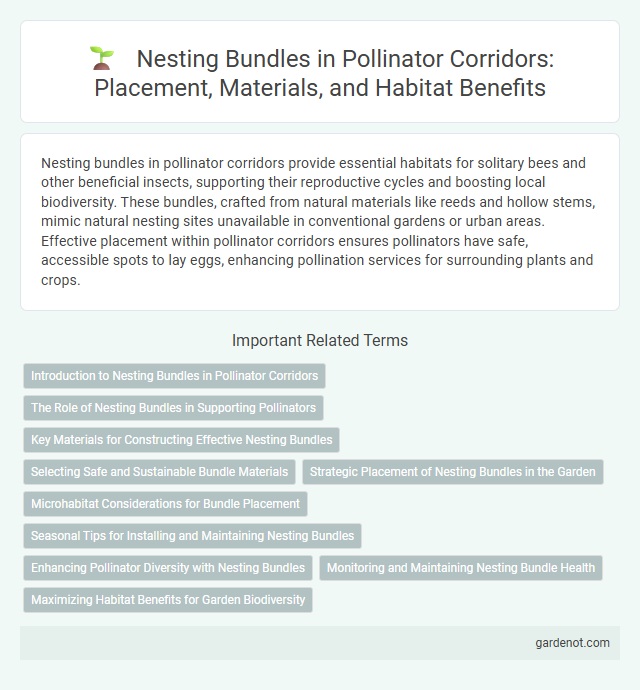Nesting bundles in pollinator corridors provide essential habitats for solitary bees and other beneficial insects, supporting their reproductive cycles and boosting local biodiversity. These bundles, crafted from natural materials like reeds and hollow stems, mimic natural nesting sites unavailable in conventional gardens or urban areas. Effective placement within pollinator corridors ensures pollinators have safe, accessible spots to lay eggs, enhancing pollination services for surrounding plants and crops.
Introduction to Nesting Bundles in Pollinator Corridors
Nesting bundles provide essential habitats for solitary bees and other pollinators within pollinator corridors, supporting biodiversity and ecosystem health. These bundles typically contain hollow stems or drilled wood blocks, mimicking natural nesting sites to encourage reproduction and population growth. Incorporating nesting bundles into pollinator corridors enhances habitat connectivity, promoting effective pollination services across various landscapes.
The Role of Nesting Bundles in Supporting Pollinators
Nesting bundles provide essential habitats for solitary bees, offering protection and insulation for their offspring in pollinator corridors. These structures mimic natural nesting sites, promoting biodiversity by enhancing pollinator populations crucial for ecosystem health. By supporting various species' nesting needs, nesting bundles directly contribute to the sustainability of pollination services in agricultural and natural landscapes.
Key Materials for Constructing Effective Nesting Bundles
Effective nesting bundles for pollinator corridors rely on key materials such as hollow plant stems, dried grasses, and wood blocks with drilled holes, which provide essential shelter for solitary bees and other pollinators. Using untreated natural fibers ensures a chemical-free environment that supports healthy larval development. Incorporating a variety of hole diameters between 2 to 10 millimeters maximizes species diversity by accommodating different pollinator sizes and nesting preferences.
Selecting Safe and Sustainable Bundle Materials
Selecting safe and sustainable materials for nesting bundles is crucial to support pollinator health and promote ecological balance. Using natural fibers like untreated straw, dried grasses, and bamboo ensures non-toxic environments for solitary bees and other pollinators to nest safely. Incorporating locally sourced, chemical-free materials reduces environmental impact and enhances the effectiveness of pollinator corridors.
Strategic Placement of Nesting Bundles in the Garden
Strategic placement of nesting bundles in the garden enhances pollinator habitat by providing essential shelter close to flowering plants, facilitating efficient foraging. Positioning bundles in sunny, sheltered locations with diverse plant species nearby supports a variety of solitary bees and beneficial insects. Ensuring connectivity between planting zones within the pollinator corridor maximizes nesting success and biodiversity conservation.
Microhabitat Considerations for Bundle Placement
Nesting bundles for pollinator corridors require careful microhabitat consideration to ensure optimal placement, such as proximity to native flowering plants and shelter from harsh weather conditions. Ideal locations feature well-drained soil and minimal pesticide exposure, supporting diverse bee species' nesting behaviors. Strategic placement near undisturbed, sunny areas enhances microclimate stability, increasing pollinator nesting success rates.
Seasonal Tips for Installing and Maintaining Nesting Bundles
Nesting bundles provide essential shelter for solitary bees and other pollinators, enhancing biodiversity within pollinator corridors. Install bundles in early spring or late fall when pollinator activity is minimal to maximize occupancy and protection. Regularly inspect and replace bundles every one to two years to prevent mold growth and parasite infestations, ensuring optimal habitat conditions.
Enhancing Pollinator Diversity with Nesting Bundles
Nesting bundles provide essential habitats that support a diverse range of solitary bees and other native pollinators by offering protected spaces for egg-laying and larval development. Incorporating varied materials like hollow stems, wood blocks, and natural fibers within these bundles increases species-specific nesting preferences and promotes pollinator population resilience. Effective use of nesting bundles in pollinator corridors enhances biodiversity, leading to improved pollination services for local ecosystems and agricultural crops.
Monitoring and Maintaining Nesting Bundle Health
Regular inspection of nesting bundles helps detect signs of wear, mold, or pest infestation to ensure optimal habitat conditions for solitary bees. Maintaining cleanliness and replacing damaged materials promptly supports healthy brood development and increases pollinator success. Detailed monitoring of environmental factors like moisture and temperature allows early intervention to sustain the nesting bundle's structural integrity and functionality.
Maximizing Habitat Benefits for Garden Biodiversity
Nesting bundles provide essential nesting materials and habitats that support a diverse range of native pollinators, enhancing garden biodiversity. Incorporating various natural fibers such as straw, hollow stems, and wood shavings into the bundles maximizes habitat suitability for solitary bees, butterflies, and other beneficial insects. Strategically placing these bundles near flowering plants and protected from harsh weather increases pollinator nesting success and garden ecosystem resilience.
Nesting bundle Infographic

 gardenot.com
gardenot.com